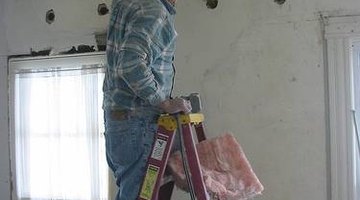How to Insulate Interior Walls That Are Already Drywalled
Insulating a wall that's open because of new construction or remodeling is simple. Insulating a finished wall is a lot more complicated, but it might be worth it if your walls have no internal insulation and your heating bills are through the roof.

The preferred method is to cut holes between each stud and use an insulation blower to fill the wall with loose insulation. Professional services are available to do this, or you can do it yourself if you're confident with your wall-patching skills.
Things You Will Need
- Electronic stud-finder
- Tape measure
- Pencil
- Rented insulation blower with loose insulation (consult the instructions for the amount needed for your wall)
- Drill
- Hole saw bit for the drill, slightly wider than the hose on the insulation blower
- Several cloths
- Dust mask
- Mesh drywall tape
- Premixed joint compound for drywall seams
- Drywall knife
- Drywall sandpaper
- An assistant
Tip
If the room has a drop ceiling, take out the tiles by the wall and cut the holes above the drop ceiling, so you won't have to repaint the walls. If your exterior siding is vinyl and easily removed, consider taking off strip and blowing the insulation in from the outside, then putting the siding back on.
Warning
Don't cut your holes near electrical fixtures.
-
Use your stud-finder to locate all of the studs on the wall that's going to be insulated. The studs will likely be 16 inches apart. Put pencil marks centered between them, 6 inches down from the ceiling. Continue across the wall, until you have pencil marks between every set of studs.
-
With your hole saw, cut out a circle at each mark. The hole should be slightly larger than the hose on your rented blower. Save each cutout piece, marking the back of it to indicate which hole it goes into.
-
Put on your dust mask. Load your blower with loose insulation. Guide the end of the hose into the first hole. Wrap a cloth around it to seal it. Have your assistant turn on the machine. Continue holding the hose as the insulation is blown into the wall. When the insulation starts backing up to the hose and the machine starts making a higher-pitched noise (like a clogged vacuum cleaner), have your assistant turn off the machine.
-
Pull out the hose and move to the next hole. Repeat the process until all the sections have been filled with insulation.
-
Patch the first hole by stuffing additional loose insulation into it until it's tightly packed inside the hole. Set the circular wall cutout piece that you saved back into the hole, letting the packed insulation brace it from behind. Press mesh drywall tape strips over the cutout piece, covering the circle and a few inches of the surrounding wall. Use your drywall knife to spread joint compound over the mesh. Repeat for each of the holes.
-
Let the drywall compound dry for a day. Sand it, reapply a second coat, then sand it again the next day. Repaint the wall.
The Drip Cap
- Insulating a wall that's open because of new construction or remodeling is simple.
- Insulating a finished wall is a lot more complicated, but it might be worth it if your walls have no internal insulation and your heating bills are through the roof.
- With your hole saw, cut out a circle at each mark.
- Load your blower with loose insulation.
- Wrap a cloth around it to seal it.
- Have your assistant turn on the machine.
References
Photo Credits
- http://www.flickr.com/photos/ryanross216/865763942/
- http://www.flickr.com/photos/ryanross216/865763942/
More Articles



